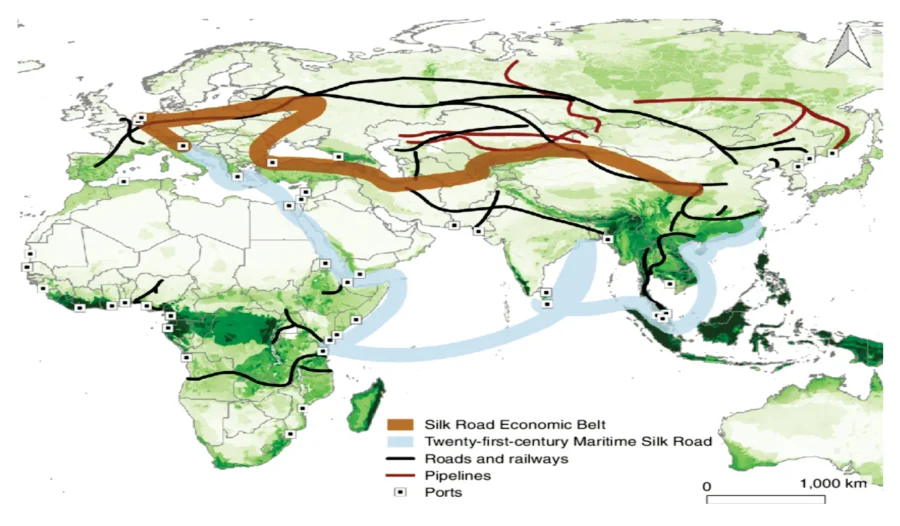Green Silk Road drives sustainable development in BRI landscape
THE Belt and Road Initiative (BRI) remains one of China’s most important global programs. In the past, most efforts were related to promoting the primary targets of the initiative, the land-based Silk Road Economic Belt and the sea-based 21st Century Maritime Silk Road. In recent years, China has expanded its efforts with the introduction of the Digital Silk Road, Green Silk Road, Health Silk Road and Polar Silk Road. Developments in these four areas have already changed the BRI landscape. Delving into these specific dimensions of the BRI will further demonstrate the initiative’s future roadmap and showcase a clear picture of relevant investment implications.
Among the four pillars introduced respectively in digital, green, health and polar, the Green Silk Road looks to make BRI projects greener and more sustainable. Chinese policymakers have increasingly focused on the sustainable BRI in recent years. The scope of the Green Silk Road includes reducing carbon emissions, cutting pollution and protecting biodiversity, while also ensuring improved economic opportunities for all countries involved. We believe that there are three main reasons behind China’s push to develop the Green Silk Road.
First, it fits into the growing global trend of prioritizing sustainable development. The Green Silk Road can be viewed as an effective solution to promote the implementation of the United Nations’ 2030 Agenda for Sustainable Development.
The Green Silk Road also serves as a key enabler of China as it seeks to achieve its goals of peaking carbon dioxide emissions by 2030 and achieving carbon neutrality by 2060. Climate change is one of humanity’s greatest challenges and concerted efforts are required globally, especially in emerging and developing economies. These countries face rising energy needs as they grow, industrialize and urbanize. Infrastructure investment decisions today can lock in emissions trajectories for decades and make or break the ability of countries to achieve their sustainability objectives. This underscores the importance of the Green Silk Road in driving sustainable development in the Belt and Road region.
Second, since the launch of the BRI, Western academia and civil society have voiced concerns about the alleged environmental impacts of extensive infrastructure development. The Green Silk Road is a response to such criticism and lays a solid foundation for wider global recognition of the BRI.
Third, many countries involved in the BRI are lagging in terms of sustainable development. China’s emphasis on the Green Silk Road allows the country to set green standards for BRI projects and make sustainability a defining feature of BRI cooperation agreements. Looking back, we have witnessed that Green Silk Road progress demonstrates the great efforts undertaken in a broader sense.
Chinese officials have actively promoted the Green Silk Road by setting up various guidelines and partnership agreements. In late 2018, China released the Green Investment Principles (GIP) for the BRI — a set of principles for greener investments in countries and regions participating in the BRI. As of June 2021, 39 large international financial institutions had embraced the GIP. In 2019, the BRI International Green Development Coalition was established to engage in dialogue, exchanges, joint research, capacity building and other activities. It has since attracted more than 150 Chinese and foreign partners from more than 40 countries, and has garnered a positive response and widespread support from the international community.
In mid-2021, China also published the Green Development Guidelines for Overseas Investment and Cooperation and the Guidelines for Ecological and Environmental Protection of Foreign Investment Cooperation and Construction Projects. These two programs focus on environmental risk management for overseas BRI projects and supply chains.
As a key aspect of the BRI, Chinese officials have also shown significant commitment toward making energy investment in the BRI regions more sustainable. This has mainly been executed in two ways — reducing their coal-related investments and increasing their green energy investments.
Since Chinese officials declared their intention of minimizing the financing of coal power plants abroad, coal-related investments and construction projects dropped to around zero in 2021 and 2022.China is also highly committed to investments in renewable energy and solar, wind and hydropower in BRI-involved regions, which increased by 50 percent year-on-year in 2022. China dominates the global manufacturing industry for renewables, accounting for 72 percent of global solar manufacturing and 50 percent of global wind turbine manufacturing. It is thus well-positioned to help deliver low-carbon technologies to BRI countries and regions.
Chinese officials have also cooperated with local governments and corporations in countries and regions involved in the BRI to build green infrastructure. One notable example is the Lower Stung Russei Chrum hydropower station in Koh Kong province, Cambodia, which was built and is owned by a large Chinese electric company. The station entered into commercial operation in 2013 with a total installed capacity of 338 megawatts and an annual output of 1.2 billion kilowatt-hours. In operation since mid-2022, the project has generated more than 8.4 billion kWh of clean power and has helped advance Cambodia’s transition toward the greater use of renewable energy.
Another example that involves technological innovation in the renewable energy sector is a floating solar farm in Huainan, Anhui province. The site’s 160,000 solar panels were installed in 2017 by a large domestic renewable energy storage company covering a huge surface area of water that was formerly the site of a coal mine. These solar panels generate 150 megawatts of electricity a year, or the equivalent of about 53,000 metric tons of coal, demonstrating the potential of solar projects along the Green Silk Road.
Given the efforts mentioned thus far, we expect China’s BRI projects to become greener and more sustainable over the long term. We believe developments across countries and regions involved in the BRI are likely to become more sustainable with time, which can in turn support better long-term investment opportunities there. Bond issuers looking to invest in sustainable development in those regions may benefit from this mega trend over the long run.
Courtesy: China Daily









